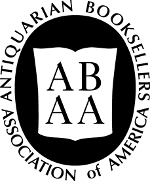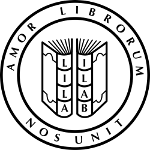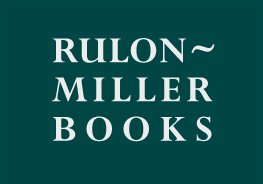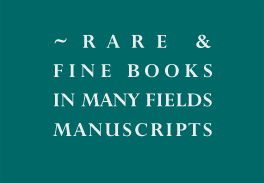Recent Acquisitions
February 20th, 2024
To order call toll-free at (800) 441-0076 or 651-290-0700
or email rulon@rulon.com
or, click on the "add to cart" link to order through our website. Phone calls and emails are generally quicker.
All books are guaranteed genuine as described, and are returnable for any reason during the first week after receipt. If you are returning an item, please let us know so we can make it available to another customer.
Shipping and handling charges are extra and billed at cost.


A note on OCLC
As is now the norm, OCLC counts are tentative, at best, as we recognize that searches using different qualifiers will often turn up different results. Searches are now further complicated by the vast numbers of digital, microfilm, and even print-on-demand copies, which have polluted the database considerably, making it difficult, without numerous phone calls or emails, to determine the actual number of tangible copies. Hence, even though the counts herein have been recently checked, most all should be taken as a measure of approximation.

1. Re-examination of the localities of human antiquities at Abbeville, Amiens, and Villeneuve. [1868]: .
$150
8vo, offprint from the American Journal of Science an Arts, Vol. XLV, March 1868; pp. [2], 181-190; drab wrappers, manuscript title on upper wrapper; wrapper chipped, else very good. Gift inscription to Minnesota Historical Society from the paleontologist Othniel Charles Marsh on upper wrapper. Andrews was a surgeon by trade but had a notable side career in paleontology. This report is from his only visit to Europe.
Yale, Newberry, Wesleyan and Cincinnati University in OCLC.

2. [Automobile Travel.] A June motor jaunt. The rambling tale of a summer motor trip . 1923: Free Press Company, .
$175
First edition, 12mo, pp. 77, [1]; frontispiece, a number of illustrations from photographs taken along the way, as well as line drawings; about fine in original green cloth stamped in gilt on upper cover.
The story of a four-week, 4400-mile motor trip from Minnesota to the Atlantic coast and back, in a 1922 Jordan brougham, via Wisconsin, Michigan, Ontario, the Adirondacks, the Berkshires, the White Mountains, Massachusetts, and return via Quebec. The first leaf is a printed presentation greeting, with Aunt Emma written in, in pen: "done into booklet form and presented to [Aunt Emma & her family] with the Christmas greetings and best wishes of the author December, 1923."

3. Gatherings. [Peterborough, New Hampshire]: 1990.
$5,000
Edition limited to 2 signed and numbered copies, consisting of a title leaf, and 16 cast fiberglass and mixed media pages, plus a printed colophon leaf, contained in a folding clamshell box 12" x 10½" by Barbara Mauriello.
This work has never been exhibited and has never been offered for sale until now. It is the first editioned artwork Harriet Bart created and was suggested to her by the late Tony Zwicker who suggested that Harriet create editioned books. It is described in the colophon as "a visual journal made at the MacDowell Colony in New Hampshire from January 23 to February 28, 1990."
The images are all on fiberglass sheets, some printed, some tinged with color, some printed in blind. Harriet drew the images with a dremel drill into heavy firm plastic sheets cut to size; she then “cast" or printed the images herself on fiberglass, placing fiberglass and medium on to the plate.
Since then, "Bart’s work has been exhibited extensively throughout the United States and Germany, and she has completed more than a dozen public art commissions in the United States, Japan, and Israel. She has been the recipient of fellowships from the Bush Foundation, McKnight Foundation, MacDowell Colony, Virginia Center for Creative Arts, NEA Arts Midwest, and the Minnesota State Arts Board.
"Since 2000, Bart has published numerous fine-press books and mixed media bookworks. She has won three Minnesota Book Awards, most recently in 2015 for Ghost Maps. Her work is included in many museum, university, and private collections. In 2020, the Weisman Art Museum in Minneapolis presented "Harriet Bart: Abracadabra and Other Forms of Protection." Curated by Laura Wertheim Joseph, Abracadabra… will be the first retrospective and monograph of her work. Bart is a guest lecturer, curator, and founding member W.A.R.M. and the Traffic Zone Center for Visual Art in Minneapolis, MN" (artist's website).
Laid in is a photocopied sheet by Bart on the nature of fiberglass and its effects on humans.

4. Three poems. Translated by James Merrill. 1987: Aralia Press, .
$250
Edition limited to 225 copies on Rives Light from Spectrum types; folio, pp. [12]; original printed blue wrappers; fine. From the library of Kim Merker.
This copy with a presentation from the printer, Michael Peich, to his friend and mentor Kim Merker on the colophon. "Kim - At last! Mike. 18.4.88."
Cavafy (1863-1933) "was a Greek poet, journalist, and civil servant from Alexandria. A major figure of Modern Greek literature, he is sometimes considered the most distinguished Greek poet of the 20th century" (Wikipedia).

5. [Commonplace Book.] Religious and miscellaneous extracts [cover title]. ca. 1830s]: .
$200
12mo, ca. 180 pages, a limp sheep binding with manuscript title on the upper cover; joints starting, but generally very good. Some pages towards the back are little faint, but still legible.
Filled to the brim with transcriptions of poems, sermons, quotations from philosophers, newspaper and magazine articles, and meditations of famous writers and thinkers, all in a tight, meticulous hand, including some extracts in French. Judging from the authors quoted and dates of journals cited, this commonplace book was probably compiled in the first third of the 19th century. There is one entry dated 1836.
Included are extracts from The Rambler; Langsdorf's Travels; Johnson's Letters to Mrs. Thrale; Crabb's Parish Register; Carne's Letters from the East; Memoirs of Lindley Murray; Herrick's Poems; The Golden Verses of Pythagoras; Poems of Wordsworth; Sidney's History of England; a lengthy extract from Reynolds' Coronation Society; another lengthy extract from Dwight's System of Theology; Miriam, or The Power of Truth, a Jewish Tale, by the author of Influences; Blunt's History of the Life of Saint Paul; Chambers Edinburgh Journal; the Sermons of Thomas Newlin, and others.

6. The Iliad. Translated by Robert Fitzgerald. Cambridge, Mass.: 1973.
$1,500
Ribbon copy typescript of the first six books of The Iliad as translated by Fitzgerald, consisting of a typed cover letter signed from Fitzgerald to Kim Merker, 21 typed leaves of "Revisions in Book I [-VI]," a typed title page, a typed dedication "For Sarah," and approximately 211 typed leaves of Fitzgerald's translation of Books I-VI. Throughout, there are perhaps three dozen small corrections in ink by Fitzgerald, as simple as adding an accent mark, the occasional insertion of a word, and in two or three instances, the crossing out or addition of a short phrase. The whole is bound in a black ELBE spring binder (so removeable), with the printed label Iliad in red on the spine.
The cover letter reads in part: "I have now gone over Books I through VI of my Iliad for the last time, and here are the corrections and revisions ... The whole poem is now finished in draft ... I'd like you to have these pages at once so that the changes can be incorporated in your copy. What is the state of that enterprise, anyway ... That page sent in January was very promising..."
In 1970 Merker published Fitzgerald's The Iliad. Book 8, lines 553-565, at the Windhover Press (see Berger, Printing and the Mind of Merker, A9). He also published Pages from The Iliad, Windhover Press, 1976 (Berger A12): "When Robert Fitzgerald came to read at Iowa, he and I had talked about my doing his Iliad ... I had bought thousands of sheets of Windhover paper ... I had ordered Spectrum type and had designed some pages for the Iliad using Centaur display caps for the beginning of the page I was doing. ... I had made some sample pages but had given up the idea of doing The Iliad; I realized it was an insane task..."
In the published version of the book the dedication reads: "For Sarah [Morgan], and for [their children] Ughetta, Benedict, Maria, Michael, Barnaby, and Caterina."

7. [Iowa Center for the Book.] Counter. Nos. 1 - 10 [almost all published]. 1994-2000: University of Iowa Center for the Book, .
$100
10 issues in all, 11" x 8½', the first issue a tri-fold, the balance running from 12 to 36 pages; illustrated, including tip-ins; fine. This is Kim Merker's own set, from his library. The eleventh and last issue, oddly missing, appeared in 2001.
Among the contributors are Barry Moser, Tim Barrett, James Mosley, Alastair Johnston, Roderick Cave, Jim Trissel, Gerry Lange, Charles Seluzicki, Johanna Drucker, Hillary Gardner, and Merker himself, among others.
This journal is not found in OCLC.

8. Journal of a medical doctor studying yellow fever in El Salvador. 1924-25: .
$1,250
Manuscript diary, 8" x 6½", pp. 111 with text almost exclusively on rectos, plus 89 blank pages at the back; telegrams and newspaper clippings tipped or laid in; stiff card boards backed in cloth; chip to lower board, some creasing and wear to boards, some splitting to telegram folds, text clean and sound.
The journal includes daily entries starting from Muller's arrival in El Libertad November 13, 1924, his establishment of a laboratory and the results of regular testing, experimentation, and trips to inspect cases of yellow fever throughout the region, with notes ending abruptly on Feb. 7th, 1925. Muller was sent to El Salvador under the auspices of the Rockefeller Institute. His diary includes newspaper clippings tracking his own activity, as well as news about disease and telegrams from officials and colleagues. The majority of Muller's work appears to have been animal experiments using guinea pigs and rabbits, but he also makes trips with his associates to hospitals and a hacienda to inspect patients or acquire tissue or autopsies. A significant portion of the diary consists of detailed medical cases of suspected or confirmed cases of yellow fever or malaria. He also frequently performs blood tests (described as Pfeissers), and in the later half of the diary searches out milkweed insects. His work brought him in contact with the top of the El Salvadorean government, including the president (with calling card tipped in), as well as other doctors. Tipped in is a business card and telegrams from two Japanese doctors, still a rarity outside of Japan at that time, J. Hattori and Hideo Noguchi.

9. The Volume Library: a concise, graded repository of practical and cultural knowledge designed for both instruction and reference. 1912: The W. E. Richardson Company, .
$75
First edition, small folio (approx. 11½" x 9"), pp. [6], 11-485, [1], 48 (color maps), 535-830, xviii (index); text largely in triple column; plates (some in color), numerous tables, several illustrations in the text; original morocco-backed green cloth stamped in gilt on upper cover and spine; the whole a bit rubbed, but generally very good and sound.
A general, all-purpose reference book for the masses. Among the contributors, with pictures and affiliations are 58 distinguished men (Frederick Starr and David Starr Jordan among them); and two distinguished women, Susan Francis Chase (from Buffalo State Normal School), and Elizabeth Harrison (Chicago Kindergarten College). Contains sections on The Kindergarten, Primary Education, Secondary Education, Industrial Education, Normal Schools, Higher Education; Arts & Sciences, including language, literature, and religion; Government & Law; Trade & Industry, including business & commerce; a universal gazetteer, a dictionary of biography, and a "multiplex" dictionary.

10. The China journal of science & arts, vols. 2-18. Shanghai: The China Journal, 1924-1933.
$1,750
17 vols. in 18, an unbroken but incomplete run starting with vol. 2 no. 1 and ending at vol. 18 no. 6, about 300-375 pages per bimonthly volume, excepting vol. 3 which was monthly and double the size. About 15-20 plates per number; brown library buckram excepting vol. 2 which is in green decorated cloth, gilt titles on spines; ex-Seattle Public with their stamps and bookplates; hinges in vol. 2 cracked and a few leaves nearly loose; 2 plates lacking in vol 5, 4 plates dogeared in vol. 18; pages 161-162 excised from vol. 9; the occasional bumping and rippling to paper, all else very good overall.
Together with: an odd issue of The China Journal, Vol, XXIX, no. 2. in original wrappers; waterstaining to spine, binding nearly perished, one article with heavy pen annotations, fair.
From an article on the journal's history: "The original inception for the journal came when Mr. Arthur de C. Sowerby and Professor C. R. Kellogg of the Fukien Christian University were on a short hunting and biological trip in the mountains north-west of Foochow ... The need of a biological journal in China had been discussed, and Mr. Sowerby, urged by the professor, made up his mind then to start such a journal, should adequate support be forthcoming. A few months later he met Miss Clarice Sara Moise, who, in the spirit of adventure of so many young American women of the present generation and of her pioneer ancestors who crossed the great American plains in the [eighteen] fifties, was travelling in China on her way round the world. A close friendship was formed, and, naturally, in due course the subject of the proposed journal was discussed.
"The main difficulty in successfully starting a biological journal was the question of finance, since it was obvious that there were not enough biologists in China to give it sufficient support in this direction... It was here that the knowledge of the practical American business woman came in. During the deliberations that followed the conclusion was reached, that, since there were not enough supporters to warrant the founding of a journal of biology alone, the latter's scope should be extended to include every branch of science, as well as travel and exploration and the arts in their relation to China and the Far East..."
As per its mandate each issue includes a mix of reporting on art and science, with articles on numismatics, antiquities, literature in translation, travel, reports on hunting and fishing excursions, natural history, and kennel club news. Most issues include material and photos on hunting (for science), and pictures of dogs with articles on their breeding and kennel club contests. Travel notes are largely on territories in China, but many excursions are made to Bali, South Asia, Korea, Taiwan, Java, the Philippines, the Middle East, and even into Africa. Contributors include Orvar Karlbeck, Jiang Kanghu, Floyd Tangier Smith, A. M. Tracy Woodward, A. W. Grabau, Chiu Bienming, Clarence Burton Day, George Kin Leung, Harrison Forman, Martin Lindsay, Aleko Lilius, and so on, representing explorers, collectors, foreign residents, second generation Chinese-Americans who migrated back to China, and, naturally enough, a number of scientists.

11. [Stenography.] An essay intended to establish a standard for an universal system of stenography, or, short-hand writing... . [1810]: reprinted from the London copy for James Cation, by Websters & Skinner, .
$500
First American edition, 8vo, pp. [11], 12-80; 11 engraved plates of shorthand at the back; original blue paper-covered boards, cream paper shelfback; spine partially perished but on the whole a very good, sound copy.
Introduced in England in 1786, Taylor shorthand was an influential and dominant system of shorthand until it was eventually superseded by Pitman. "Indeed, it is upon the Harding adaptation of Taylor that Isaac Pitman wisely based 'Phonography,' and to the sterling qualities of the Taylorian ground work added the light and airy, but strong, Pitmanic superstructure which has enabled Pitman shorthand ('the genus, rather than the species') to tower above all competing systems like a modern sky scraper above the four- and five-story architectural masterpieces of our fathers."
Aside from a spurious title that failed to attribute its system to Taylor, printed in 1809, this is the first book of Taylor shorthand printed in the US.
Westby-Gibson p. 216.

12. American Book Collector. Chicago, New York, et al.: 1957-87.
$750
A blast from the book-trade past. After AB Bookman's Weekly, the American Book Collector was the most important trade magazine on the American scene in the last half of the 20th century, with many interesting articles by many renown authors and book people: Walter Hart Blumenthal, Lawrence S. Thompson, Frederick R. Goff, Jeff Dykes, Thomas McDade, James Lamar Weygand, Vardis Fisher, Madeleine Stern, Roderick Cave, Herbert West, Robert Metzdorf, Rockwell Kent, L. Frank Baum (a first printing of one of his stories), Justin Schiller, Martin Gardner, John Mayfield, Lawrence Romaine, Jacob Zeitlin, Frederick B. Adams, Thomas M. McDade, Carl Hertzog, Norman Forgue, and Vincent Starrett, among others.
The serial began publication in 1950 and ended in 1976. The New Series, under the patronage of William Burton, began again in 1980. The magazine included book reviews, auction announcements and reports, obituaries, book fairs, both display and classified ads, catalogue announcements, and other departments of interest to both the collector and dealer.
This long run of nearly 200 issues comes from the library of Kim Merker and includes: Volume VIII, 1957-58, nos. 7-10 only; Volume IX, 1958-59, nos. 1-10 (complete); Volume X, 1959-60, nos. 1-10 (complete); Volume XI, 1960-61, nos. 1-10 (complete); Volume XII, 1961-62, nos. 1-10 (complete); Volume XIII. 1962-63, nos. 1-10 (complete); Volume XIV, 1963-64, nos. 1-10 (complete); Volume XV, 1964-65, nos. 1-10 (complete); Volume XVI, 1965-66, 9 issues (lacking no. 5); Volume XVII, 1966-67, 10 issues (complete); Volume XVIII, 1967-68, 10 issues (complete); Volume XIX, 1968-69. 10 issues in 9 (complete); Volume 20, 1969-70, 8 issues (complete); Volume 21, 1970-71. 8 issues (complete); Volume 22, 1971-72, 8 issues (complete); Volume 23, 1972-73, 6 issues (complete); Volume 24, 1973-74, 6 issues (complete); Volume 25, 1974-75. 6 issues (complete).
And then there's the hiatus. But beginning in 1980 a New Series was launched, with articles by Richard Gabriel Rummonds, Philip Hofer, B. H. Breslauer, Joseph Blumenthal, Madeleine Stern, Ralph Sipper, Herbert Cahoon, Anne Bromer, Mildred Abraham, Dan Traister, William Burton, George Bixby, Jerry Kelly, J. M. Edelstein, Matthew Bruccoli, Christopher Edwards, Felix Oyens, Bill Reese, and myself. Included are: Volume 1, 1980, nos. 1-6 (complete); Volume 2, 1981, nos. 1-6 (complete); Volume 3, 1982, nos. 1-6 (complete); Volume 4, 1983, nos. 1-6 (lacking no. 3); Volume 5, 1984, nos. 1-6 (complete); Volume 6, 1985, nos. 1-6 (complete); Volume 7, 1986, nos. 1-12 (complete); Volume 8, 1987, nos. 1-6 (end).

13. [Trans-Atlantic.] Account of the voyage of the schooner 'Albatros'. n.d. ca. 1955]: privately printed, .
$500
11" x 8½" mimeograph typescript, 2 leaves of introductory matter, plus 29 leaves of log; half-page sketch of Albatross; post-bound in green wrappers; some toning of the text; very good.
Account of a trans-Atlantic voyage from Rotterdam to Barbados in the Caribbean, via Falmouth and Maderia (of which there is a good account), from July 31 to September 9, 1955. A well-written account of a relatively tame voyage, but the interest in Albatross runs deep. The owner was the American aviator, filmmaker, and novelist, Ernest K. Gann who had purchased Albatross in 1954 from the Dutch merchant marine where she was used as a training ship. Gann rerigged the schooner as a brigantine and she largely cruised the eastern Pacific and the Caribbean for three years, during which time Albatross survived a tsunami in Hawaii. She was also used in the 1958 film Twilight for the Gods (starring Rock Hudson and Arthur Kennedy), whose script and underlying novel by the same title were written by Albatross's owner Gann.
Subsequently, Albatross was acquired by Christopher B. Sheldon's Ocean Academy, Ltd. of Darien, Connecticut for use for preparatory college classes and sail training. Over the next three years, Sheldon and his wife Alice ran programs for up to 14 students in the Caribbean and Pacific. On one of these cruises, from the Bahamas to the Galapagos, they were hit by a sudden squall west of the Dry Tortugas. Albatross heeled over suddenly and sank almost instantly, taking with her six of the crew. Much controversy surrounded the sinking, many thinking that Albatross was top-heavy and unseaworthy due to the reconfiguration of the rig and superstructure by Gann.
An account of the history of the vessel, and its subsequent demise, accompanies this log.

14. The Century Dictionary: an encyclopedic lexicon of the English Language. Revised and enlarged under the superintendence of Benjamin E. Smith. 1911: The Century Co., .
$500
Large 4to, 12 volumes, including the separately printed Atlas, and the volume of Proper Names; plates (some in color), illustrations in the text; text in triple column; full original beige cloth stamped in gilt; some light wear and spotting, but generally a very good, sound set.
In 1882 Charles Annandale greatly enlarged Ogilvie's Imperial Dictionary (1850), which came to be the basis for The Century Dictionary, an American work modeled after the OED. Whitney, the well-known Sanskrit scholar and linguist, was its editor. "Beautifully printed...it is surely one of the handsomest dictionaries ever made" (Landau, Dictionaries, p. 72).

15. [Windhover Press.] Divided touch divided color: XII poems. Woodcuts by Peggy Fitzgerald. 1995: Windhover Press, .
$750
Edition limited to 200 copies, small, thin folio, pp. xx, [2]; fine copy of an attractive book, designed by Kim Merker and printed by Don Howell, and in a blue paper-backed paste-paper binding by Pamela Spitzmueller. From the library of Kim Merker.
Berger, Printing and the Mind of Merker, 104: "What had started out to be a very simple, undecorated book ... turned into a wonderful production on the part of everyone concerned."
This copy is accompanied by approximately 80 proof pages (mostly 11½" x 15" but a dozen or so half-page and quarter-page strips) by the illustrator, Peggy Fitzgerald, almost all of them with her notes in pencil regarding inking, placement, coloring, and the like.

16. [Windhover Press.] Flowers of August ... Drawings by Keith Achepohl. 1983: Windhover Press, University of Iowa, .
$850
Edition limited to 260 copies, square 8vo, pp. [28]; illustrated throughout with floral drawings by Keith Achepohl; fine copy in original green cloth, gilt lettering on spine. From the library of Kim Merker.
These seven poems appeared as a numbered sequence in Others for 1919: An Anthology of the New Verse, edited by Alfred Kreymborg. Williams included three of them individually in Sour Grapes and later again in The Collected Earlier Poems. The complete sequence is reprinted here for the first time.
This copy is accompanied by a series of 23 artist's proofs on sheets approx. 18" x 11½", 2 smaller, 3 wih sections cut out, and 13 with 16 small post-it notes with instructions and/or titles by Achepohl.
Berger, Printing and the Mind of Merker, 82.





























































